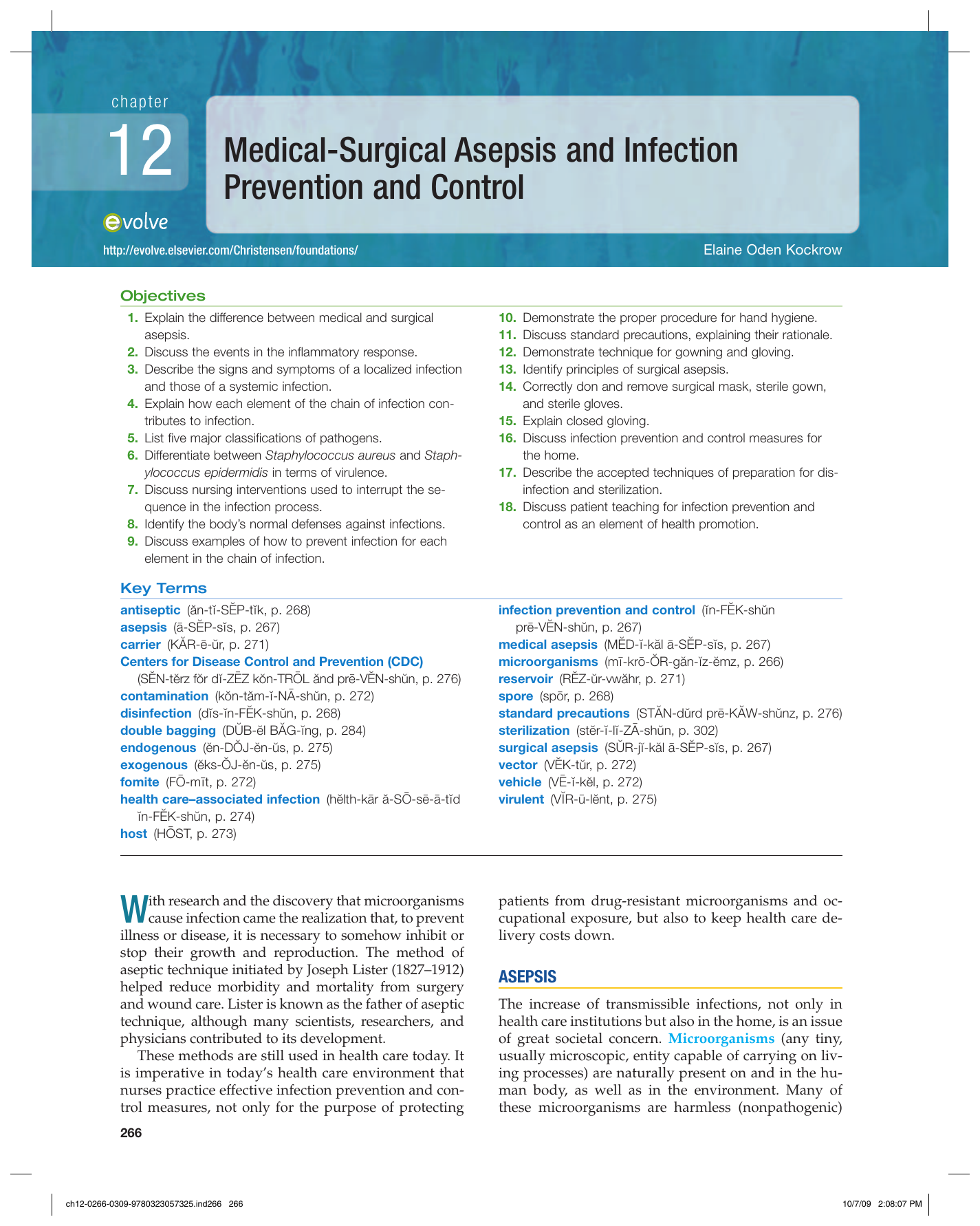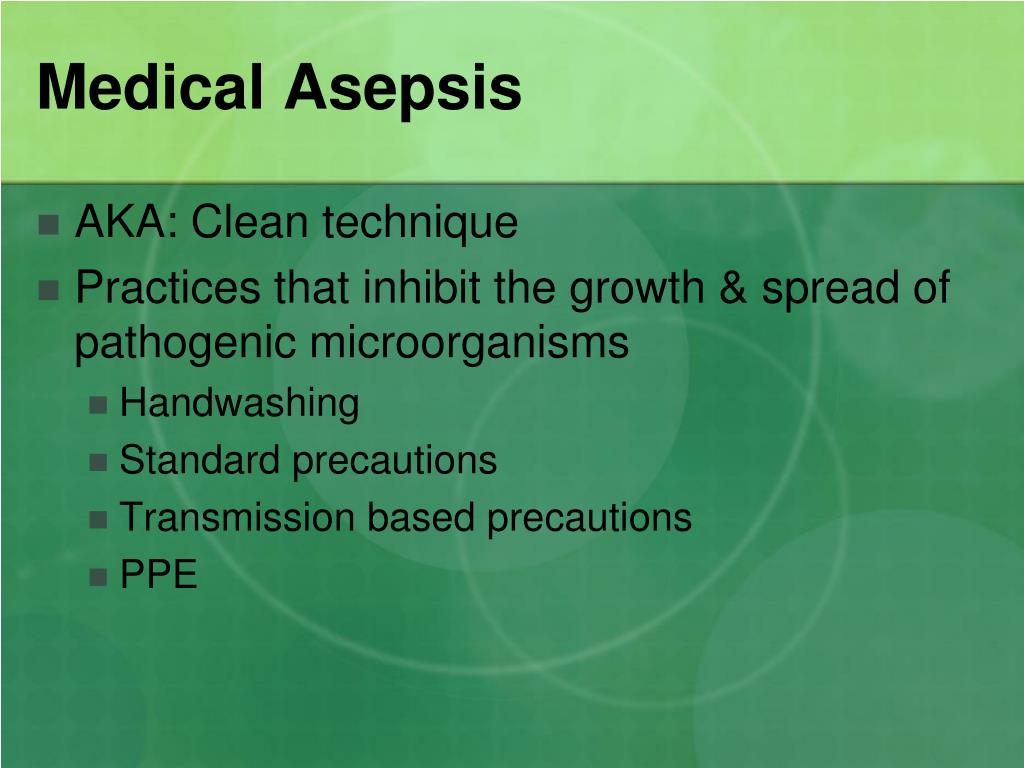

- #Infection control and medical asepsis how to
- #Infection control and medical asepsis pdf
- #Infection control and medical asepsis free
The fundamental principle of an aseptic technique/ANTT incorporates protecting key elements of the equipment that should remain free from micro-organisms, for example, the inside of a sterile dressing or the barrel of a sterile needle (NICE, 2012). Examples of when to use a medical aseptic technique It provides a comprehensive set of principles including ANTT, which aims to achieve surgical asepsis the ANTT approach is widely used in hospitals and community settings (NICE, 2012).īox 1. The ANTT® (aseptic non-touch technique) framework was developed to provide consistent step-by-step guidance for an aseptic non-touch technique that can be applied to several invasive procedures, including insertion of urinary catheters and peripheral cannulas, phlebotomy and administration of intravenous drugs (Box 1) (Rowley et al, 2010). Rowley et al (2010) recognised the need for a systematic and robust approach to aseptic technique that aims to prevent the contamination of wounds or other susceptible sites by removing variation in practice (Rowley et al, 2010). A ‘clean technique’ can be classed as medical asepsis or standard aseptic technique, as it uses the same principles. The term ‘clean technique’ is often used to describe the procedure for dressing chronic wounds it includes hand hygiene, preparation of a clean area with use of clean gloves and sterile instruments, such as scissors and forceps (Wound, Ostomy and Continence Nursing Society, 2012). Surgical asepsis includes procedures to eliminate, rather than reduce, micro-organisms from an area and is practised by surgical teams and nurses in operating theatres and procedure areas, including interventional radiology (NICE, 2012). Medical asepsis – sometimes referred to as standard aseptic technique (Association of Safe Aseptic Practice, 2015) – aims to reduce the number of organisms and prevents their spread by use of standard principles of infection prevention (Loveday et al, 2014).
#Infection control and medical asepsis how to
Healthcare workers who perform an aseptic technique should receive training in how to correctly perform the procedure this should include a competency assessment (Loveday et al, 2014).Ī variety of terms are used to refer to aseptic technique this can be confusing for frontline healthcare staff (Loveday et al, 2014). An aseptic technique is required for many clinical interventions including wound dressing and insertion of invasive devices, as well as the maintenance of these devices (Loveday et al, 2014). What is asepsis?Īseptic technique is a process or procedure used to achieve asepsis to prevent the transfer of potentially pathogenic micro-organisms to a susceptible site that may result in the development of infection (Wilson, 2019). With the increased focus on antimicrobial resistance (AMR) there is also a need to carefully consider antibiotic usage, and prevention of infection can help to reduce the need for antimicrobials in the first place (HM Government, 2019). Indeed, as far back as the mid-1800s, the association between good hand hygiene and reduced infection rates was identified by Ignaz Semmelweis (Wilson, 2019). It could be suggested that understanding the principles of asepsis goes back as far as Florence Nightingale, who made the links between good hand hygiene and reduction in wound infections in 1855 (Rowley et al, 2010).

The term asepsis means “the absence of potentially pathogenic micro-organisms” (Loveday et al, 2014). To reduce patients’ risk of developing a HCAI, it is vital to prevent the transmission of micro-organisms between staff and patients when undertaking any invasive procedure (Loveday et al, 2014) this can be achieved by asepsis. These infections are more likely to occur in patients with invasive devices, such as peripheral canulas, vascular access devices or urinary catheters in situ, or after invasive procedures (NICE, 2012). It is estimated that 300,000 patients each year in England will develop a healthcare-associated infection (HCAI) (National Institute for Health and Care Excellence, 2012).
#Infection control and medical asepsis pdf
Scroll down to read the article or download a print-friendly PDF here (if the PDF fails to fully download please try again using a different browser).This article is open access and can be freely distributed.This article has been double-blind peer reviewed.Nursing Times 116: 38-41.Īuthors: Andrea Denton and Carole Hallam are independent nurse consultants, AC Independent Nursing Consultants.

This article, the first in a two-part series, describes the principles of asepsis and part 2 will describe the procedure for changing a simple wound dressing.Ĭitation: Denton A, Hallam C (2020) Principles of asepsis 1: the rationale for using aseptic technique. Aseptic technique is a core competency for many nurses.


 0 kommentar(er)
0 kommentar(er)
